Laying a sewer pipe in the ground
When planning the construction of a new house, we take into account our financial capabilities, but very often it happens that costs are much more than expected. There is practically no money, but not all communications have been completed yet. How to get out of this situation? You can reduce your expenses if the laying of the sewer pipe in the ground and inside the house is done independently.
In this article we will talk about the technology of laying sewer pipes in a closed sewer system. And we will begin with the project of system.
System design
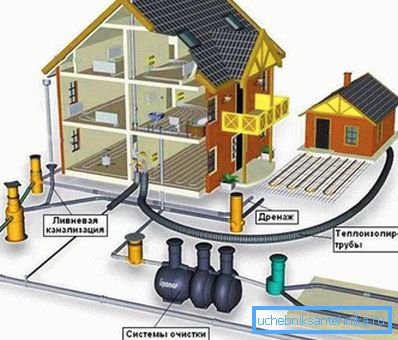
In developing the project of autonomous sewage on the site the following facts are taken into account:
- The composition of the soil on the site.
- Ground water level.
- The depth of soil freezing.
- Mechanical loads on the system.
The project indicates the location of all points of sewage discharges inside the house and in the yard, the location of the septic tank, the water intake point, the installation line of the sewage pipes, the turning points, the junction of the inner and outer pipes, the installation of auditors.
At the design stage, it is determined from which material it is better to use pipes, the need for thermal insulation works, the number of adapters, whether it is necessary to equip a drainage system.
Features of pipe laying
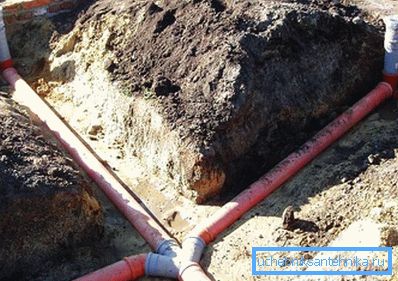
In order for the wastewater disposal system to function smoothly, it is necessary to take into account factors affecting its work:
- For autonomous sewer systems use pipes whose diameter is not less than 110 mm.
- Plumbing equipment to the system can be connected with pipes having a diameter of 50 mm.
- The horizontal angle of adapters and taps should be equal to 45 degrees.
- To make the slope of the sewer pipe from the point of discharge to the septic tank. Per meter of pipe slope must be at least 2 cm.
- For sewage passing through the site, installed inspection and inspection wells.
- The pipeline sewer system is warmed, if it is laid above the level of soil freezing.
- Silicone or special sealant is used to seal the joints.
- The sewage system begins at the point of discharge and ends with a sewage treatment plant or sink.
- For the withdrawal of gas accumulations the whole system is equipped with ventilation holes.
- For laying iron pipe need special equipment.
- The installation of the sewer pipe begins after marking the entire system on the site.
Tip! If you intend to use pipes made of cast iron in an autonomous sewer system, you must buy pipes that are coated with a special compound against corrosion.
You can make a sewage system without using heavy machinery yourself, if you choose polymer or plastic pipes.
Polymer sewer system

Many owners of country houses refuse to use cast-iron pipes for sewage systems due to their heavy weight and labor-intensive installation, choosing more modern plastic products. Lightweight pipes can be laid without additional labor. In addition, the plastic has excellent strength and resistance to aggressive media.
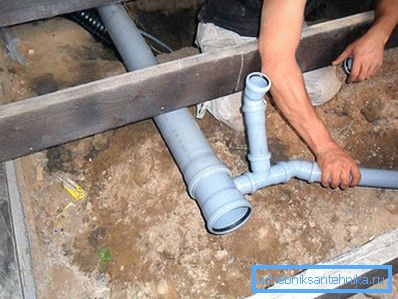
For the inside of the sewer is better to use PVC pipes. They perfectly withstand drains of different temperatures.
Tip! For laying the external sewage system, use polypropylene and polyethylene pipes and other elements of the system of these materials.
Products perfectly withstand the pressure of the soil and its freezing, without losing shape or splitting. In addition to these characteristics, pipes and septic tanks made of polyethylene and polypropylene do not corrode and are completely sealed. The fittings are also made of these materials, which makes it possible to lay a high-quality pipeline for the drainage system.
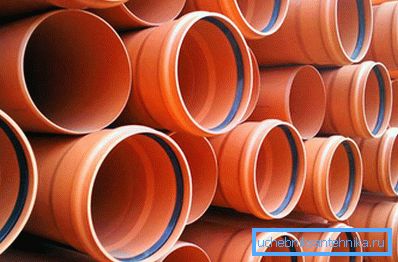
The rules for laying sewer lines require compliance with one important condition - the absence of sharp turns and level differences. It is in these places that traffic jams are most often formed. Experts recommend installing inspectors or manholes in differential wells and places of turns.
Tip! At installation of sewer pipes it is necessary to follow regulations. They contain all the rules, including information about the depth of the sewage system. You will need a SNiP P-G.3-62.
Installation
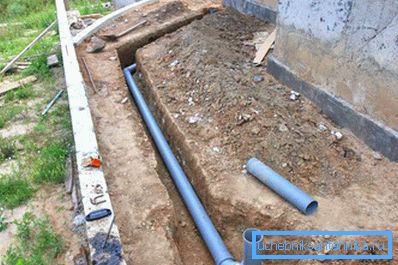
All necessary information has been thoroughly studied, the depth of the gasket has been calculated, the required diameter of the pipe and adapter have been purchased, a cleaning plant has been selected and now the installation process can be started.
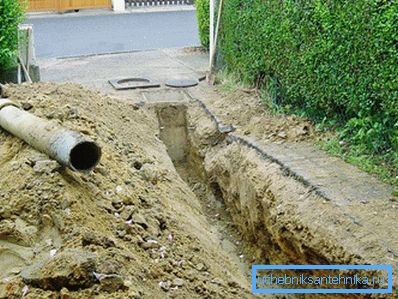
First of all, it is necessary to dig a pit for a cesspool or septic tank in the place provided by the project. After that, start digging trenches for laying pipes. The depth of the pit and trench should be at least 20 cm below the projected level of installation of the elements of the sewer.
Tip! Pipes perfectly maintain low temperature, but the water in them can freeze in extreme cold. To avoid unpleasant situations, it is best to wrap the sewer pipes with insulating material, and then fill up with a small layer of dry mix. To prepare the backfill, take five parts of sand and one part of cement.
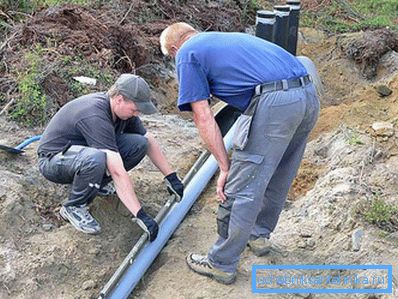
For the good operation of the entire system, it is important to observe the projected pipe slope. On a flat surface, the depth of the trench near the house will be less than near the septic tank. If the plot has a natural slope from the house to a septic tank, it is enough to dig a trench of equal depth along the entire length of the pipeline.
Tip! On a plot with a steep slope, it is best to divide the sewage system into several compartments with different levels, installing distribution or differential wells. If you do not slow down the movement of the drain, it is possible the destruction of the sump or septic tank.

The bottom of the excavated trench must be well compacted and covered with a layer of sand or crushed stone of medium fraction. The depth of laying pipes in a trench may be completely different. At high groundwater the pipe and deep freezing of the soil, the trench is dug deep, and the pipe is laid in it as high as possible. At low groundwater, the pipe is laid in the center of the trench or closer to the bottom.

Before laying check pipes for the maintenance of garbage. Clean pipes if necessary. Installation of sewer pipes begin with the points of the drain in the house, bringing one pipe to the street. Then from the house, the pipes are laid in the direction of the septic tank or cesspool, adding other branches from the street drains along the way.
Tip! Remember to use silicone grease or seal rings when connecting two pipes. In places of branching and pipe turns, install auditors.

Pipes connect as closely as possible with the force pushing until it stops. When the pipes are fully connected and laid, it is necessary to carefully wrap them with any insulating material. In addition to auditors and manholes, install a ventilation pipe near the house. If the sewer line is long, you can install another one or two pipes. In the drain hole or septic tank should be its own ventilation.
Tip! Do not rush to immediately fall asleep system. First make a control discharge of water. He will show you how well the pipe laying work was done.
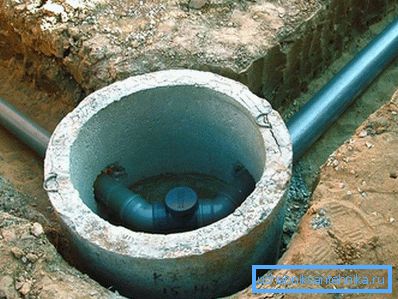
If all is well, the sewer line is first filled with 15 cm of sand with cement, and then with soil. Examiners and manholes should be at least 20 cm above the soil level.
Now you have all the information on how to lay the pipe under the ground so that the sewage system works smoothly. In addition to the stated material we recommend to watch video about laying of sewer pipes by own strength. If you did the sewer system yourself, share your experience with our readers, leaving comments on the article.
Video
Watch a video about installing a sewer system:
Watch a video about laying outdoor sewers: